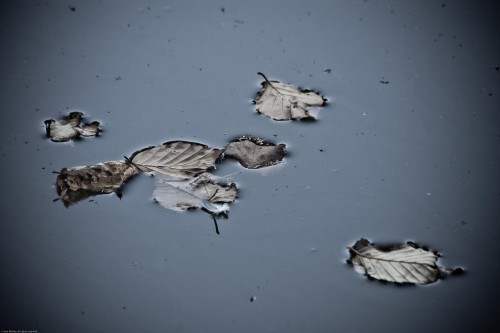This is a guest post by Saul Molloy. You can read more on Saul's blog, add him to twitter or catch up with what he's been shooting on Flickr.
Capturing light reflected from water is a time-tested technique for creating great photographic compositions and one utilised by photographers almost every time there's still water to be seen in the frame. What's not so usual is to change your focus from what's reflected on the water to what's actually doing the reflecting. Think of this a little like photographing the glass in a window rather than the scene that the window looks out on.
The meniscus of water, that shimmering film which has enough surface tension to make the life of pond-skaters complete and is the property of water responsible for all those lovely reflections photographers like to shoot, is itself quite an interesting subject for photography, since rather than a flat, boring film on top of the water it's actually a landscape with all sorts of lumps, bumps and whirls. Add to that things that actually float on the water and you get the opportunity for some colourful and interesting abstracts, and best of all it's remarkably simple to do.
The first thing you require is some water, you can use any amount of water, from a droplet to a lake, personally I prefer the lake option since it's gives a lot more opportunity to identify interesting features. Next you need a nice calm day and a camera or lens which allows manual focus. That's right, I said manual focus! The brilliant autofocus systems of modern cameras, knowing how much photographers like reflections, tends to always lock onto the image in the water rather than the surface of the water itself, somewhat ruining your intended shot.
Ideally you also want a long enough lens to take advantage of scenes which are some distance from you, or a boat I expect, though that will likely cause ripples in the water.
Finally, it's often a good idea to think compositionally about the colour and quality of the light being reflected from the water (this site is called “Light Stalking” right?), all of the shots in this article I took in the autumn, since the light bouncing off the trees provides a nice tone, but there are other things you could use, the side of a jetty, a post in the water or whatever. A tripod or monopod is also useful, though not always required, since it can make accurate manual focussing a little easier at slower shutter speeds. Consider also Depth of Field issues, here the DOF at 300mm and f/9.0 is remarkably shallow.
Half an hour shooting and some judicious wiggling of the manual focus ring will have you some interesting and unusual shots and once you've found a composition that interests you, it's worth taking several frames of it – I find that my ability to focus by eye with my DSLR is just not as good as it is on my old 35mm Pentax!
Finally, it's worth trying to isolate subjects on a plain background and experiment with making boldly contrasting scenes, then it's a simple matter of getting home and pushing your images through Lightroom to give them them a bit more ooomph. Voila, a new and interesting abstract technique!
Read More articles by Saul Molloy on his blog add him to twitter or catch up with what he's been shooting on Flickr.







8 Comments
Nice idea and some very cool shots too.
“…my ability to focus by eye with my DSLR is just not as good as it is on my old 35mm Pentax!”
I find a similar problem between my current Nikon D90 and my old Nikon FtN, which I haven’t used in 20 years. It may be more to do with the age of my eyes than the age of the film camera!
I hear you Jim!
Very nice. Love the third image…
I agree. I love how the water defines those leaves. Though if I were the photographer, Id’ve shot it in black and white.
Yeah, I never shoot in B&W, though I do plenty of post-shoot conversions, in these shots I felt that the images when converted lost something important given are almost duo-chrome in any case. In particular it was difficult in the last shot to evoke the almost metalic sheen around the leaves. I expect it would would better in other cases though.
Definitely got some great new ideas from this that I’ll be putting in to play soon. Thanks for this great article.
Cool! I’m going to try it!